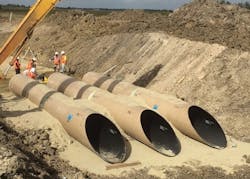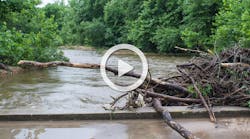About the author: Liz Moucka is a freelance writer. Moucka can be reached at [email protected] or 972.765.3733.
The push is on for governmental bodies to become better stewards of public funds. The Lower Neches Valley Authority (LNVA) in southeast Texas actively pursues that goal by maximizing utilization of its budgets and personnel. LNVA primarily self-performs maintenance work on its system, but generally does not take on larger construction projects. One particular capital improvement project was scheduled for 2017, but worsening conditions due to unusually heavy rains in early 2016 threatened the banks of the Devers Canal System in southeastern Liberty County.
LNVA staff determined that they could perform the repair project themselves. They had seen much larger-diameter fiberglass reinforced polymer mortar (FRPM) pipe installed by a contractor during a previous project and felt certain that they had the equipment and skills to install the 48-in. pipe.
LNVA is one of 23 river authorities created by the state of Texas to develop and manage the waters of the state. LNVA is responsible for freshwater management in far southeastern Texas in the entirety of Jefferson, Hardin and Tyler counties, and portions of Liberty and Chambers counties. The watersheds of the Neches River and its tributaries occupy an area of approximately 10,000 sq miles. The area receives a generous amount of rainfall, producing stream flows in the Neches and its tributaries of approximately 4.323 million acre-ft of water a year at Port Arthur, Texas, where it empties into Sabine Lake and ultimately into the Gulf of Mexico.
Although water in the Devers Canal System is pulled from the Trinity River, the LNVA acquired the Devers Canal System in 2008. The majority of the water LNVA delivers through the Devers Canal supports rice production in southeastern Liberty County.
Potential Failure
Known as the Jones Crossing, the site of the potential breach is approximately 21 canal miles downstream from LNVA’s Devers first pump station at the Trinity River. At this particular location approximately 20 miles southwest of Beaumont, an aged drainage system was piped under the Devers Canal. The canal, in turn, was piped directly under a farm access road. All three features converged at various angles at the Jones Crossing point.
“We were experiencing problems with the existing reinforced concrete pipe joints separating and allowing canal water to leak into the ditch,” said Ryan Ard, P.E., engineering manager for LNVA. “LNVA made several repairs over time to patch any leaks that appeared. Over the years, erosion and weathering had deteriorated the original timber headwalls in the drainage ditch. This ongoing erosion, exacerbated by the heavy rains in early 2015 and again in early 2016, eventually infiltrated and undermined the headwalls, allowing the banks of the drainage ditch to creep toward the canal. Had we allowed the problem to persist, the canal banks would have ultimately been breached by erosion, thereby allowing canal water to spill into the drainage ditch below.”
As originally planned, this project would be designed by LNVA staff and put out for public bid for a general contractor in mid to late 2017. Given the circumstances and the need for urgency, and because LNVA’s canal system is not in operation Oct. 31 to March 15 over the winter months due to the agricultural cycle, LNVA decided to take on the construction project internally.
The fully automated water jet cutter does not generate dust.
The Approach
The scope of the repair would include excavating and removing the existing drainage ditch and canal crossings. The drainage ditch and canal both included three runs of 48-in. reinforced concrete pipe. The pipe in the ditch measured approximately 160 ln ft and the pipe in the canal was approximately 40 ln ft. The total depth of the drainage ditch was approximately 12 ft.
LNVA professional engineers analyzed several alternative repair designs, but ultimately decided to rebuild the crossing in its original configuration. The layout was complicated by the fact that a private road crosses both the drainage ditch and the canal at this location.
Because the hydraulics of the canal and the drainage culverts had been performing satisfactorily for years, and also because of vertical space limitations, the engineers decided to use the same size pipe for the reconstruction. The goal was to maximize the depth of the canal while maintaining the existing flowline of the drainage ditch.
The original headwalls in the drainage ditch were constructed of vertical timbers.
“We wanted to go back with a hard armored headwall, such as concrete or articulated block,” Ard said. “We determined a vertical headwall in the drainage ditch would be more costly to construct and maintain over the years compared to a sloped concrete liner. Based on this decision, we requested the pipe ends be mitered at a 2:1 slope from the factory. Once installed, the ditch slope would be graded to match and a concrete liner poured for erosion protection.”
LNVA considered different types of pipe material for this application. Although corrugated metal and concrete are commonly used materials for drainage culverts, LNVA engineers considered the lifecycle cost benefit of FRPM pipe. Leakage associated with corrugated and concrete drainage culverts are generally not of concern, but over time they can cause erosion and corrosion. For this particular site where a canal, drainage ditch and road converged, the type of pipe material raised concern.
“At this diameter, the pricing was competitive with reinforced concrete pipe; however, the benefits of the centrifugally cast fiberglass reinforced pipe (FRP) outweighed that of a reinforced concrete pipe in terms of handling the material and placement during construction,” Ard said.
While the project only needed 600 ln ft of 48-in. pipe, generally an amount falling below the dollar value required for a formal bid process, LNVA nonetheless publicly advertised for bids to supply FRP. HOBAS Pipe USA was the low bidder.
Installation
LNVA ultimately chose a centrifugally cast fiberglass reinforced polymer mortar product because, according to Ard, “we have a good service history with the HOBAS product installed in various other locations on our system. We liked the fact that the joints came in 20-ft lengths and would be watertight, the pipe is lightweight when compared to its concrete counterparts, and HOBAS would factory miter the pipe ends to our specifications and install a headwall ring to be cast into a concrete headwall.”
Because it is made of fiberglass, the pipe is easily customizable, a task made easier and faster with the use of a custom-built water jet cutter, according to Kirk Eager, Southeast Texas/Louisiana sales representative for HOBAS Pipe USA. Drawings are created in 3-D mechanical CAD software and transposed into the required code. The water jet machine is then run by a computer-controlled program that produces perfectly cut pipes, quickly and in an environmentally friendly manner.
Although they had no previous experience installing this type of pipe, LNVA crews were able to install the pipe relatively easily. The manufacturer also provided Omar Carrasco, senior field representative, to observe and assist with the installation and offer tips to the crews on how to handle the pipe and bed and backfill it.
LNVA staffs several crews and operates a fleet of its own heavy equipment to perform day-to-day business. This allowed LNVA to control costs by utilizing internal equipment and manpower for construction. A six-man crew, led by James Savoy of LNVA, constructed the project utilizing two Komatsu PC240 track hoes, a John Deere D450 dozer, and a Takeuchi mini excavator and skid steer. Other pieces of equipment were rented, including small vibratory and pad-foot compactors.
The installation of the three 160-ln-ft runs in the drainage ditch took four days, while installation of the three 40-ln-ft runs in the canal under the roadway was completed in only one day. Once the new pipe was installed, LNVA crews regraded the drainage ditch slopes and reconstructed the canal banks and rock road back to their pre-existing grades. Because repairs to the roadway and canal system were performed in the agricultural off-season, the road was closed for the duration of construction, as no residences or local traffic were affected.
Because this was a fairly small project that LNVA crews were able to complete in-house, LNVA saved money by buying directly from the manufacturer and self-performing the work. HOBAS worked directly with the owner on this custom order that required ultraviolet coating and special angle cuts.


